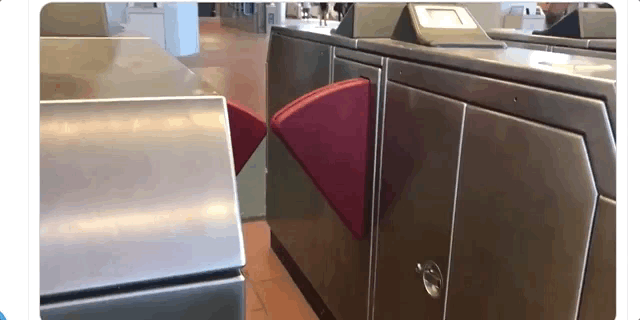
Having lived for the better part of my life in the San Francisco Bay Area, I have put in my time on the Bay Area Rapid Transit (BART) system. From it’s loud, overcrowded, clunky, and infrequent trains, to the spate of BART police shootings of young men of color, this privatized (militarized?) operation has a monopoly on public transport, and unashamedly has its will with the region with little grace.
The latest offense is the instillation of “skull crusher” “inverted guillotine” pop-up spring-loaded barriers, that could hurt or maim (it’s just a lawsuit waiting to happen).
Instead of pouring money into education, or helping the homeless, the Bay Area has now apparently prioritized metal spikes shooting up from their BART turnstiles. Way to go, gentrification!
The fact that “fare jumping” is solved by violence is telling. Instead of maybe just making the BART – a public service – into a public company, free for all riders, payed by a corporate property tax (or some other public funding in the insanely overpriced Bay), as many other localities such as Tallinn in Estonia have done, doubling down on menacing design elements further marginalizes the marginalized. BART really doesn’t lose much money at all on fare jumpers. Their financial mismanagement is sui generis. Yet, like all administrative classes, the propensity to pay themselves more to harm the poor is too tempting; it exculpates their responsibility for mismanagement (and points to the need for the region to re-buy the service to run it correctly), and instead finger-wags at “scofflaws” for being bad people, when all they really are doing is what is necessary to get around their own town when they haven’t benefited from the Silicon Valley boom.
The book Unpleasant Design discusses the epidemic of public infrastructure that makes being in public an injurious experience for those worst off. From bus benches in shelters that slope so you can’t sleep on them (you’d fall off), to “anti-homeless spikes,” sonic warfare (projecting odious or repetitive noises, like that corporately-engineered “hit” “Baby Shark“), ordinances against “sitting” or lying in public spaces for too long — rich countries, especially English-speaking ones, have declared war on public space.

Unpleasant design takes what little of the commons are left – the nooks and the crannies – and puts money into destroying them to keep out “undesirables.” This racist and classiest action is often the result of gentrification; justified to keep the zoos of the rich free of those who can’t pay their entry fee.

The psychological warfare of guillotine turnstiles makes the entire experience of public transportation less comfortable for everyone. Instead of dealing with the 80-20 principle that 80% or 90% of riders will pay no problem, and that there will always be a remainder of the population that for what ever (often very legitimate) reason cannot or will not pay, BART has chosen to harm the public, pushing more people into their polluting cars.
I’m sure before long, people will be defacing these violent turnstiles. And it is likely that the accumulated rage against BART will reduce paying ridership (despite their monopoly), actually bringing them less money than they had before–the exact opposite result than they profess to so-desperately and so-forcefully want.
The public outrage on Twitter is already loud and clear against BART’s weaponization of its service. Such aggrandizement activities miss the point of their charge: they are in the business in providing a public service, and some people can pay more, some less, and not at all. Perhaps peg BART tickets to income. Then the rich might pay $100 per ride, the poor the normal $3.40 trip, and the very poor nothing. That would be a fair approach. Our society is far from that enlightened thinking, sadly, even in that hotbed of *potential* San Francisco, Oakland, Berkeley, and environs.
But let’s not deceive ourselves. There’s a reason why you can’t take the BART to Marin County: racism. Back in the 1950’s there was a plan in place to extend the San Francisco BART to Marin (North Bay), but because of vocal refusal by residents, it failed. And now, no easy public transportation (besides the ferries) go to Marin. The Bay Area is disconnected by design, an open gated community in a natural and cultural paradise predicated on class, race, and exclusion.
Have we not evolved as a city in 70 years? Are we still just as violent towards those less fortunate than us. San Francisco is a mess because of its wealth. But at least on this case of BART structural violence, the people are having their day of reckoning.